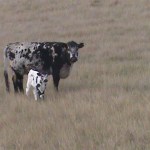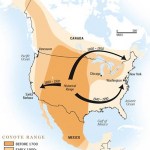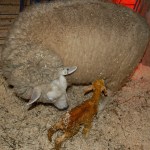zoonoses
I discuss the topic of emerging infectious diseases today over at Slate, as part of their Pandemic series.
Ebola has long been known to be a zoonotic virus--one which jumps between species. Though it took several decades to find evidence of Ebola virus in bats, these animals had previously been associated with human index cases of Ebola disease have worked in bat-infested warehouses or traveled to caves where bats roost. Non-human primates have also become infected with the virus, sometimes transmitting the virus to humans when killed primates are butchered for food. Ebola has also been suggested to infect dogs and other wild animals. However, livestock are a newer angle to Ebola virus ecology.…
Regular readers don't need to be told that I'm a bit obsessed with zoonotic disease. It's what I study, and it's a big part of what I teach. I run a Center devoted to the investigation of emerging diseases, and the vast majority of all emerging diseases are zoonotic. I have an ongoing series of posts collecting my writings on emerging diseases, and far too many papers in electronic or paper format in my office to count. Why the fascination? Zoonotic diseases have been responsible for many of mankind's great plagues--the Black Death, the 1918 "Spanish" flu pandemic, or more recently, HIV/AIDS…
This is the thirteenth of 16 student posts, guest-authored by Jessica Ludvik.
One Disease, Many Species
Brucellosis, more commonly known as undulant fever in humans or bangs disease in cattle, is one of the oldest bacterial scourges of livestock-producing nations, especially those in which the animals live in close proximity with the human population. The disease is caused by bacteria of the genus Brucella. Within this category are many species of bacteria, each almost exclusive to a particular animal species. A few of the most common seen in veterinary and human…
This is the twelfth of 16 student posts, guest-authored by Stanley Corbin.
Disease in wildlife is an important concern to the health and safety of humans and domestic animals. The expanding growth of our nation and resultant land use changes with urbanization has resulted in a shrinking habitat and fragmentation for all animals, including humans. The effects of ecological disruption are universally recognized and adversely effects wildlife through multiple mechanisms.
Hand it to the coyote (Canis latrans) for its ability to exist with humans. The resilience of this animal can be…
This is the eleventh of 16 student posts, guest-authored by Ilze Berzins.
When one hears the words “food-borne illness”, what comes to mind? For me, I think of a medium rare, pink, juicy hamburger, or something like potato salad that may be made with mayonnaise containing raw eggs, or maybe a fresh green garden salad sprinkled with sprouts. I am sure we have all heard about outbreaks or recalls surrounding these familiar dishes. And the usual suspects contaminating these food stuffs are often bacteria with familiar names such as E.coli or Salmonella. …
This is the tenth of 16 student posts, guest-authored by Jean DeNapoli.
I own a small back yard flock of sheep and lambing season is the most exciting and rewarding time of the year. Nothing is more enjoyable than watching a lamb who takes a few wobbly steps and nurses for the first time as her mother nickers encouragement. Within a day, the lamb will be playing, bucking, running, and exploring her world.
Despite the pastoral wonders of the season, lambing is also inherently stressful. I must constantly check the barn to monitor for birthing problems and help out…
Aah, the things one learns when awake at 3AM on a Saturday night. Via a few different Tweeps, I ran across this article from Men's Health magazine, titled "Urgent Warning: Sex with Animals Causes Cancer."
I probably should have just stopped there.
But no, I read the magazine article, which states:
Brazilian researchers polled nearly 500 men from a dozen cities, and found that--we're not joking around here--roughly 35 percent of the men had "made it" with an animal. That's a problem, because screwing a horse, donkey, pig, or any other animal was found to up your likelihood of developing…
By Kim Krisberg
Just a few days ago, an event in the small town of Lilburn, Georgia, may have saved the life of someone living half a world away. It wasn't a black-tie gala or a celebrity telethon. It wasn't even about a disease that most of us here in the United States think much about. In fact, it was as easy as doing what us animal lovers would do anyway: vaccinating our beloved Fido or Whiskers against rabies.
In honor of World Rabies Day, which takes place Sept. 28, Lilburn's Banfield Pet Hospital held a rabies vaccination clinic, half of the proceeds from which were donated to the…
...when it contains a weird gene conferring methicillin resistance that many tests miss.
Methicillin-resistant Staphylococcus aureus (MRSA) has become a big issue in the past 15 years or so, as it turned up outside of its old haunts (typically hospitals and other medical facilities) and started causing infections--sometimes very serious--in people who haven't been in a hospital before. Typically MRSA is diagnosed using basic old-school microbiology techniques: growing the bacteria on an agar plate, and then testing to see what antibiotics it's resistant to. This can be done in a number of…
Mark Pendergrast writes: To kick off this book club discussion of Inside the Outbreaks, I thought I would explain briefly how I came to write the book and then suggest some possible topics for discussion.
The origin of the book goes back to an email I got in 2004 from my old high school and college friend, Andy Vernon, who wrote that I should consider writing the history of the EIS. I emailed back to say that I was honored, but what was the EIS? I had never heard of it. I knew Andy worked on tuberculosis at the CDC, but I didn't know that he had been a state-based EIS officer from 1978…
There is an old vaudeville joke where a man goes to the doctor complaining about pain in his arm:
Doctor: Have you ever had it before?
Man: Yes, once before.
Doctor: Well, you have it again.
CDC reported on their weekly FluView website on Friday that the Iowa Department of Public Health (IDPH) reported to CDC that in September a boy (age not stated) had a flu like illness from which he fully recovered and for which he hadn't required hospitalization. In November IDPH determined it was swine flu, but not the pandemic H1N1 but a swine-origin H3N2. According to CDC there was "no clear exposure"…
The caves in the Dordogne department in southwest France are most famous for paleolithic cave paintings at Lascaux (the Dordogne is also famous for the being the home of microdot, whose blog The Brain Police is one of my daily reads). Now it has yet another claim to fame: the discovery of the first bat outside of the northeastern United States with White Nose Syndrome (WNS) Fungus (Geomyces destructans):
Biologists are struggling to understand a recent emerging infectious disease, white-nose syndrome (WNS), which potentially threatens >20% of all mammalian diversity (bats). WNS is a deadly…
I got an email yesterday about "a disturbing undercover video showing sick and injured pigs being dragged, beaten, pushed with forklifts and shocked with electric prods by workers to get them onto slaughterhouse kill floors." I'm glad I didn't see it as the whole thing disturbs me enough. I'm not a vegetarian, although for about a year and half Mrs. R. and I decided the only meat we would eat was fish (that's when I discovered I liked fish; for most of my life I thought I didn't and never ate it). The occasion for that meatless except for fish interlude was reading a long New York Times…
Helen Branswell, the Canadian Press's extraordinary flu reporter, is one of the few reporters who could have written the article, "Flu dogma being rewritten by a strange virus no one pegged to trigger a pandemic". She's been following flu for years and has watched as one thing after another we thought we knew about flu has been shown wrong -- by the flu virus. It's a theme we have been sounding as well for almost as long. As scientists we've seen one alleged flu truism after another was stood on its head. A couple of years ago we began to assume anything said about flu was provisional. Some…
When swine flu appeared, the pork producers were keen to say there was no connection or relationship between pigs and swine flu (even though the virus's genetic segments were all of swine origin). They didn't want anyone to call it swine flu, giving rise to the celebrated naming controversy. But then we started seeing pigs infected with human pandemic swine flu, both in the lab and in pig herds. It's likely the pigs got it from us, although which direction things went in isn't completely clear. But originally the virus made the jump from pigs to humans, probably sometime in late 2008 or…
If you are a paranoid hypochondriacal person with young children who lives in a suburb, you've come to the right/wrong place (take your pick). Because now you get to hear about Baylisascaris procyonis. What's that, you ask? The procyon part should be the tip-off, but I suppose not that many people know that Procyon is the genus to which raccoons (Procyon loto) belong. We're going to talk about raccoon latrines.
Yes, raccoons have latrines. Who would be crazy or stupid enough to build a latrine for raccoons? Other raccoons. Raccoons have communal defecating sites called raccoon latrines where…
The natural reservoir for most influenza viruses is birds, especially aquatic birds, but some versions of the virus have also become adapted to the host cells of other species, among them sea mammals, horses, dogs and of course pigs and humans (among others). How long is the list? We really don't know, as there has been little systematic inquiry into influenza hosts in the natural world. While human influenza is seasonal in the northern and southern hemispheres, where it goes in the "off season" is a matter of debate. Most flu experts think it remains at low levels in the community, spiking…
It's now fairly certain that humans have returned the favor and given H1N1/2009 to pigs, another example of a cozy flu swapping relationship now almost a century old. At the time of the 1918 pandemic, pigs were also suffering a serious influenza-like illness which was quickly dubbed "hog flu." The pigs got sick suddenly with fever and respiratory symptoms but recovered quickly and mortality was fairly low. The same thing occurred elsewhere (Europe, China) during and after the pandemic, so it wasn't hard to make a connection between the "Spanish flu" and "hog flu." But in 1918 it wasn't known…
As is usual (routine? no, nothing routine about this) in an evolving epidemic contradictory and confusing numbers are appearing. Some of them are the result of information lags (tallies not being updated), some are the result of using different criteria for counting (suspect versus probable versus lab confirmed, etc.), some are just rumors. WHO is saying that in Mexico there are only 7 confirmed deaths, 19 more lab confirmed cases, 159 probable cases and some 1300 being evaluated, based on official reporting to them by officials of a member state, the Mexico. Everyone knows there are many…


